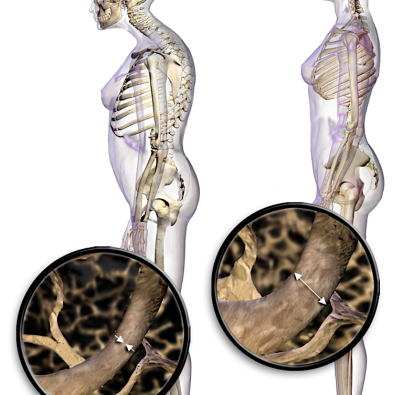WORLD OSTEOPOROSIS DAY (WOD), on October 20 each year, marks a year-long campaign dedicated to raising global awareness of the prevention, diagnosis and treatment of osteoporosis. WOD aims to make osteoporosis and fracture prevention a global health priority by reaching out to health-care professionals, the media, policy makers, patients, and the public at large.
OSTEOPOROSIS ITSELF IS SILENT WITH NO EXPRESSIONS OR INDICATIONS THAT IT EXISTS. The number one problem is the increased risk of bone fractures. Osteoporotic fractures occur in situations where healthy people would not normally break a bone; they are thus labeled as fragility fractures. Fragility fractures appear in the spine bones called vertebrae, rib, hips, and the wrist.

Courtesy Bloodless Spine Surgery
A COMPRESSION FRACTURE is not a fracture where the bones are cracked into two pieces. The vertebrae may collapse from above and or below. Typically, patient complain about sudden onset back pain. Some people develop radicular pain. With time, progressive collapse and involvement of more spine bone fractures, people tend to stoop forward, experience a loss of height and develop pain.
ASK YOUR DOCTOR ABOUT A DEXA SCAN: For women over 65 and men over 70, DEXA scans are only appropriate for those with moderate risk of fracture or when the results will change the patients care plan. Younger women and men ages 50 to 69 should consider the test if they have risk factors for serious bone loss. This test tells your bone mineral density. Osteopenia is a condition that begins as you lose bone mass and your bones get weaker. This happens when the inside of your bones become brittle from a loss of calcium. It is very common as you age. Total bone mass peaks around age 35. People who have osteopenia are at a higher risk of having osteoporosis. Osteoporosis is a bone disease that occurs when the body loses too much bone, makes too little bone, or both. As a result, bones become weak and may break from a fall or, in serious cases, from sneezing or minor bumps.
BECOME AWARE EARLY: PREVENTION OF OSTEOPOROSIS should ideally begin in childhood, aiming to achieve high peak bone mass and overall a healthy lifestyle throughout life. Awareness of osteoporosis and its problem could lead to taking the steps necessary to prevent stooping, fractures and pain.
In order to prevent bone loss during the middle ages and avoid late stage fractures, one must also consider safety. Great bones are made by paying attention to calcium and vitamin D intake, the pounding of weight-bearing exercise, and strength training.
FALLS ARE THE BIGGEST RISK FACTOR and can be prevented with house modifications and exercises aimed at balance and agility. Therapeutic intervention in the late ages is recommended, such as grab rails and no loose carpets. International and national strategies are present throughout social media which are aimed at common mistakes and identification of those risks.
ASK YOUR DOCTOR TO CHECK YOUR VITAMIN D LEVELS. Worldwide, more than 50% of the population is vitamin D deficient. The American Academy of Orthopedic Surgeons and recent research support that the body needs at least 1000 international units per day for good health – depending on age, weight and growth. In general, babies (especially mothers who are breastfeeding) and small children should intake at least 400 IU of Vitamin D daily. Children over age 5, adolescents, and adults should get a minimum of 1000 IU of Vitamin D each day. Check with your medical doctor to assess your levels by blood test.
If you shun the sun, have milk allergies, or follow a strict vegetarian or vegan diet, you might be at risk for vitamin D deficiency. Low blood levels of vitamin D has been associated with increased risk of death from cardiovascular disease, severe asthma in children, cognitive impairment, and cancer. Research suggests that vitamin D could play a role in the prevention and treatment of type1(juvenile) and type2 (adult onset) diabetes, hypertension, glucose intolerance and multiple sclerosis.
CALCIUM IS CRITICAL IN THE MAKING OF BONES. The table shows recommended dosages, and sources.


Tod Snyder, Physical Therapist
SIMPLY PUT GOOD POSTURE IS THE PROPER ALIGNMENT OF THE SPINE. Optimal alignment leads to the most efficient position to carry the spine. Misalignment of the spine leads to increase forces seen by the spine. Over time misalignment can lead to tons of pounds of forces placed upon the spine per year. Proper posture and alignment of the spine compounds positively over the years.
WALKING IS A WEIGHT BEARING EXERCISE
Gregory James Chiaramonte, M.D.
Walking in all forms is beneficial. Walking builds strong bones, promotes mental clarity, involves use of the heart and lungs, and promotes facet joint mobility and nerve root mobility and function. Uphill walking is different in that the spine joints are in a flexed open position, which might be helpful in conditions where there is nerve root tightness. Uphill walking may even help patients with spinal stenosis and other ailments because it opens up the spinal channel. Downhill walking is different since the spine joints are in an extended closed position, which could worsen conditions where there is already nerve root tightness. The spinal channel tends to close as well.
SUNLIGHT AND DAYLIGHT

Toronto based master architect Dermot Sweeny www.sweenyandco.com has designed millions of square feet of high-performance human comfort workspaces.

Dermot emphasizes daylight, sunlight using daylight harvesting systems. Modern workers are demanding sustainability, flexibility, and comfort. As more people are finding themselves spending the greater part of their workweek in the office, they look to their workspace for inspiration. The days of working within the walls of a building absent of abundant natural light and is always too hot or too cold, are numbered. Future studies might find that special attention to building design results in less pain and suffering, and improved happiness and performance in the workplace.





















